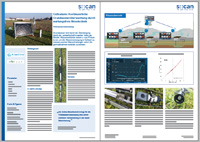Groundwater is in danger in many countries due to agricultural overfertilization and liquid manure. Water associations use s::can products to monitor the groundwater supply in real-time and to take immediate countermeasures against contaminations for example in case of elevated nitrate (NO3) levels.
Nitrate alarm: continuous groundwater measurement with maintenance-free s::can sensor technology

Background
Background – Nitrate from overfertilization endangers groundwater
Massive overfertilization of the fields, due to farming, has increasingly endangered groundwater for decades. Alarming nitrate and pesticide levels can be, for example, measured in some regions in Austria, Germany, Switzerland and the Netherlands. This harms the environment and also consumers are bearing many of the costs: For water suppliers it is getting more time-consuming and costly to meet the legal requirements of the drinking water regulations. Contaminations in the groundwater are often detected too late and dangerous concentrations of nitrate and pesticides are potentially reaching the end consumer.
High-resolution nitrate monitoring of the groundwater over several months & Validation of online nitrate values in the laboratory
s::can’s solution – optical online-sensors
A monitoring program was installed in Southern Styria in order to analyze groundwater for drinking water production and the impacts of consequential issues from fertilization and liquid manure on the water quality in most of the complex catchment areas. These are sites with measurement systems for event-related sampling. The systems combine optical online-sensors with sporadic sampling systems for the detection of nitrate, turbidity, dissolved oxygen, conductivity, groundwater levels as well as hydrocarbons, BTX and pesticides.
With a systematic self-monitoring of the groundwater quality in the catchment area of drinking water wells, an information advantage is gained, in order to be able to react fast and sufficiently and to set predictive counteractions in the wells. The evaluation of the specific measuring sites took place on the basis of the catchment areas by consensus removal from the individual wells (existing groundwater models). The measuring sites are placed between a 90 and 120-day flow limit to the wells. Thereby, enabling to react preventatively on the developments of the groundwater quality.
Benefits – Low maintenance and low power consumption
Especially in regions with groundwater problems, innovative solutions for smart sensors, data acquisition and data transfer as well as data management are gaining vast significance. Since these s::can solutions have a low power consumption, are long-lasting and enable low-maintenance measuring methods, they are very suitable for stationary, decentralized, battery-operated installations. Additionally, countermeasures can be taken immediately as soon as contamination events occur.
“Online monitoring technology is an essential improvement in quality assurance for drinking water suppliers.” (commented Johann Frank, Ph.D., CEO JR-AquaConSol)

